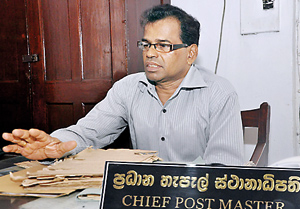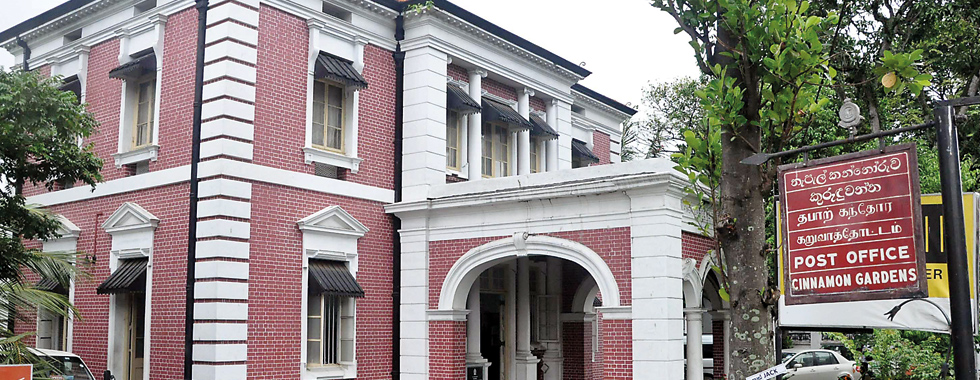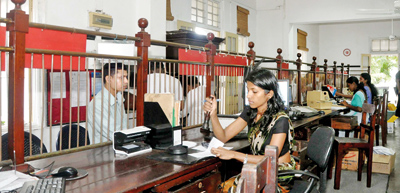108 and the ‘Grande Dame’ stands tall
The ‘Lady in Red and White’ is not a slip of a girl sitting shyly and coyly any more but has taken her rightful place as the ‘Grande Dame’ of Cinnamon Gardens as true matriarchs should do. Having been very much a part of the hustle and bustle of Lipton’s Circus and nestling in the shadow of the mighty Town Hall for more than a century, 108 years to be exact, she has now been gently but firmly coaxed into revealing the full grace of her vintage.

Mr. Ariyaratne who saw the potential
The right person for this ‘place’ had to come along though to realise the grandeur beneath the thick layers of grime and dust and the beauty hidden behind a tangle of trees and foliage. Otherwise why would she be the ‘chosen one’ from among 651 post offices dotting the country.
In tribute to her age and stock, it was Chief Postmaster H.K. Ariyathilake, 58, who saw the true potential of this archaeological gem and set about the arduous task of bringing back her glory. For him, it was nothing new, for as a youth from Galle who had just joined the Postal Department his first stint was at another heritage building – the Nuwara Eliya Post Office.
When he arrived at Cinnamon Gardens in 2011, his end-station as he retires in 2015, after 36 years, he had been PM of 10 Post Offices and served 17 years at the Parliament Post Office even though the usual stint of duty at one station is only four years. He found to his dismay that the two-storey building was dilapidated and neglected, under cover of huge trees, an overgrown garden and bundles of barbed-wire. Many people who converged in that area used the premises as a toilet. One set of the two gates fronting Dharmapala Mawatha was shut permanently and the only indication that it was a Post Office was a thahaduwa roughly scratched with the name, more to wave-off rather than beckon any who may venture in.
As had been the practice, Mr. Ariyathilake settled in as Chief Postmaster, with his family ensconced upstairs and began the long haul of restoring the Cinnamon Gardens Post Office.
Its history flows easily from his lips, as he sits at his desk behind the busy counters. Gathering bits and pieces he has been able to cobble together, he says, the beginnings way back in 1905.
The building had functioned as a Telephone Exchange in the first three years along with the Central Telephone Exchange (CTO) at Fort, Mr. Ariyathilake explains, pointing out that some time between 1908 and 1910 it had begun serving the people as a Post Office. As he set about getting the garden cleaned up of the thick undergrowth, he stumbled on the original board which was good as new except for a little bit of rot at the bottom. Now this board hangs proudly in the front-yard.

The Cinnamon Garden Post Office: Old world charm with new expanding services
Needing funds to bring back this Post Office to its original state and knowing that the Postal Department may not be able to foot the bill, with the blessings of Postal Ministry Secretary Hemasiri Fernando and then Postmaster General M.B. K. Dissanayake he sought the goodwill of donors. Support came from the General Manager of the Sampath Bank, Aravinda Perera, who knowing the value of all things old immediately spoke to his own Chairman.
Raising Rs. 3 million and expending a massive effort, in a short span of two months we were able to bring it back to what it should be, in time for the celebration of World Postal Day on October 9, 2011, he recalls, stressing that all repairs and renovations were under the direction of the Director-General of Archaeology, Dr. Senarath Dissanayake as this is a heritage building.
Invaluable assistance also came from big neighbour – the Colombo Municipal Council. “They took out 25-30 lorryloads of kunu,” he says, ever grateful to then Deputy Municipal Commissioner, Visakha Dias. While cleaning up and restoring the premises, Mr. Ariyathilake also had to rebuild discipline and service among the employees. Although short-staffed– where 19 officers are required, this Post Master has only eight officers and six minor staff–the work goes on without disruption.
Setting the record straight, Mr. Ariyathilake says that the delivery of mail was handled in the early days by the General Post Office (GPO), the job being done now by the Central Mail Exchange. Never was this done at the Cinnamon Gardens Post Office. It does only collection and despatch.
We ran the Postal Service Bank, he says, pulling out frayed and crumbling ledgers as old as the 1920s. By 1972, through a directive of then Finance Minister N.M. Perera, the Postal Bank was converted to the National Savings Bank, the agents of which are still the Post Offices.
Another prized possession is a yellowed and tattered ‘Post Office Notices’ with the British emblem which would have hung prominently for the public to see. Those were the days when the King’s Birthday was a Post Office Holiday and the lowest denomination stamp was just a cent. While a postcard to the UK was six cents and the “current” rate of Exchange was £ 1=Rs. 13.50.
Interestingly, people were also urged to subscribe through the Postmaster for the wireless broadcasting service: “For a licence fee of Rs. 10 per annum you may listen to a daily programme consisting of – General News, Mail News, Weather Reports, Time Signals, Concert Oriental and Western Music, Lectures, the latest Gramophone Music &c., &c.”
With justifiable pride, Mr. Ariyathilake shows us the value of this Grande Dame………the timber roof of the ground floor, the columns with their intricate work at the top, the fans of long ago in which not even a razor blade has been changed, the wooden windows and doors with their original awnings and two sturdy safes.
The British had imported all the stuff needed for the Post Office including the Burma teak, he says in wonder, adding that it is intact yet. Side by side with the old lies the new, with Mr. Ariyathilake expanding the services being offered here to increase the revenue for the government. While money orders may now be sent electronically, people can also pay not only their electricity bills here, but also their Mobitel bills and their HSBC credit card bills.

Staff at the counters attending to the public. Pix by Indika Handuwala
“I realized that people often asked for photocopying facilities, as otherwise they had to go across to the busy Eye Hospital junction,” he says, adding that he has hired a machine for the Post Office and is now making a small profit on this service. The other services provided are lamination and binding, making the Post Office a one-stop centre for the nearly 4,000 customers who walk in daily, while the number of registered letters being generated from here is 3,000.
The human touch has also not been lost and the Sunday Times learns how many a customer leaves behind valuables on a daily basis, the commonest being pairs of spectacles. The most memorable was a bulging wallet left on the counter one day. When it was brought to Mr. Ariyathilake’s notice, he had looked for a name and address, only to find bank and credit cards and money in it. Calling the bank which had issued the credit card, he had explained what had happened and when the bank refused to reveal the customer’s phone number, requested the bank to pass on a message to him.
It was a forever- grateful customer who not only came to the Post Office to collect his wallet and thank them profusely but also took time to write to the PMG in praise of the staff of the Cinnamon Gardens Post Office.
comments powered by Disqus

